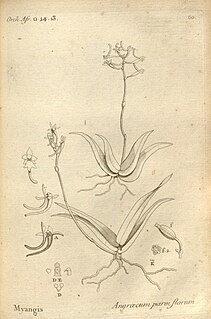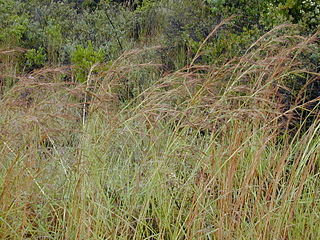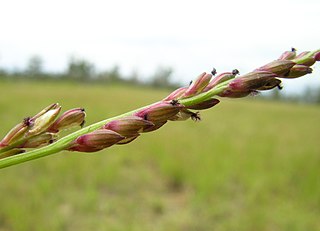
Polytrias is a genus of Asian, African, and Pacific Island plants in the grass family, commonly called Java grassBatiki bluegrass, Indian murainagrass, or toto grass. The only known species is Polytrias indica, native to West Africa, Seychelles, the Indian Subcontinent, southern China, Southeast Asia, New Guinea, Fiji, and Micronesia. It is also cultivated as a lawn grass in other tropical regions, and naturalized in scattered locations in tropical North and South America.

Sarcocephalus is a genus of flowering plants in the family Rubiaceae. It holds two species of shrubs or trees native to tropical Africa. Sarcocephalus latifolius has edible fruits known as African peach, Guinea peach, Sierra Leone peach or country fig.

Angraecopsis is a genus of plants in the family Orchidaceae. It was first described by Fritz Kraenzlin in 1900 and given its name on account with the genus' similarity to Angraecum species. Angraecopsis are native to Africa, Madagascar, Réunion, Mauritius and the Comoros. The growth habit is rather small and the leaves emerge from a woody stem.

Chionochloa is a genus of tussock grass in the family Poaceae, found primarily in New Zealand with one known species in New Guinea and another on Lord Howe Island. Some of the species are referred to as snowgrass.

Hyparrhenia is a genus of grasses. Many species are known commonly as thatching grass.

Caesia is a genus of herbs in the family Asphodelaceae, subfamily Hemerocallidoideae, native to Australia, New Guinea, Madagascar and Southern Africa. The mostly 3-lobed seed capsules contain rounded black seeds. The genus was named in honour of Federico Cesi (1585-1630), an Italian scientist.
- Caesia alpina Hook.f. - alpine grass-lily - New South Wales, Tasmania, Victoria
- Caesia calliantha R.J.F.Hend. - blue grass-lily - New South Wales, Tasmania, Victoria, South Australia
- Caesia capensis(Bolus) Oberm. - Cape Province of South Africa
- Caesia chlorantha F.Muell. - New South Wales, Queensland, Western Australia
- Caesia micrantha Lindl. - New South Wales, Tasmania, Victoria, South Australia, Western Australia, Queensland
- Caesia occidentalis R.Br. - Western Australia
- Caesia parviflora R.Br. - pale grass-lily - Queensland, New South Wales, Tasmania, Victoria, South Australia, Western Australia
- †Caesia rigidifolia F.Muell. - Queen Victoria Springs in Western Australia but extinct. Last recorded near Zanthus in 1875.
- Caesia sabulosaBoatwr. & J.C.Manning - Cape Province
- Caesia setifera Baker - Queensland, Western Australia, Northern Territory, New Guinea
- Caesia subulataBaker - Madagascar
- Caesia viscida Keighery - Western Australia
Pseudopentameris is a genus of South African plants in the grass family, found only in Western Cape Province.

Arundinella is a widespread genus of plants in the grass family, common in many tropical and subtropical regions.
Coelachne is a genus of Asian, African, and Australian plants in the grass family.

Loudetia is a genus of African, Arabian, and South American plants in the grass family.

Tristachya is a genus of African and Latin American plants in tribe Tristachyideae within the grass family.
Dilophotriche is a genus of West African plants in the grass family.
Dregeochloa is a genus of African plants in the grass family.

Entolasia is a genus of African, Australian, and Papuasian plants in the grass family.
Monocymbium is a genus of African plants in the grass family.
Rhytachne is a genus of plants in the grass family. They grow principally in wet savannahs in Africa and the Americas. More specifically, they tend to prefer transitional zones between marshes and drier upland savannahs. In the Americas the genus can be found from southern Mexico and Cuba south to northern Argentina, while in Africa it is present below the Sahara, including in Madagascar. Twelve species are included, of which nine are African, two are American, and one, Rhytachne subgibbosa, is found on both continents. The genus is closely related to Coelorachis.
Merxmuellera is a genus of African plants in the grass family. It takes its name from Hermann Merxmueller, a German botanist and taxonomist from the 20th century with a special authority in the African flora.
Danthoniopsis is a genus of Asian and African plants in the grass family.

Tristachyideae is a tribe of the Panicoideae subfamily in the grasses (Poaceae), native to tropical and subtropical regions of Africa, Asia, and South America. There are around 70 species in eight genera. The tribe belongs to a basal lineage within the subfamily, and its genera were previously placed in tribes Arundinelleae or Paniceae, subfamily Arundinoideae, or the now-obsolete subfamily Centothecoideae. Species in this tribe use the C4 photosynthetic pathway.

Protea madiensis, commonly known as the tall woodland sugarbush, is a flowering shrub which belongs to the genus Protea. It is native to the montane grasslands of Sub-Saharan Africa.












